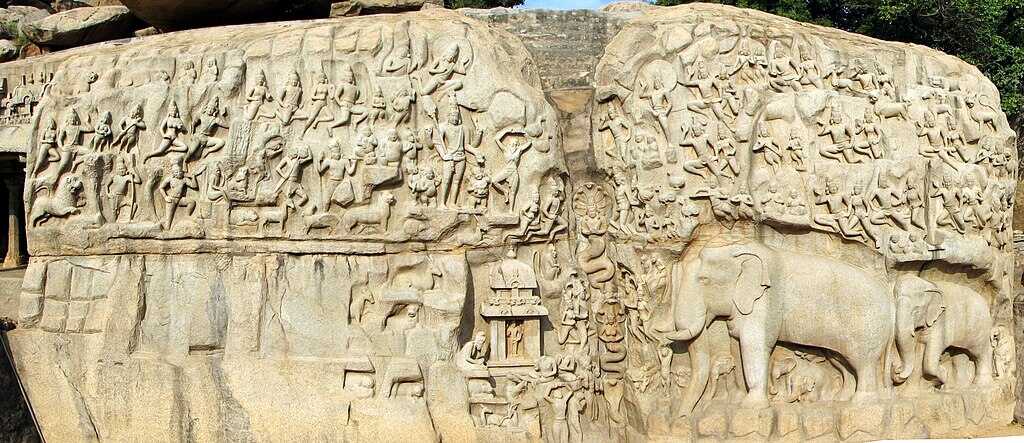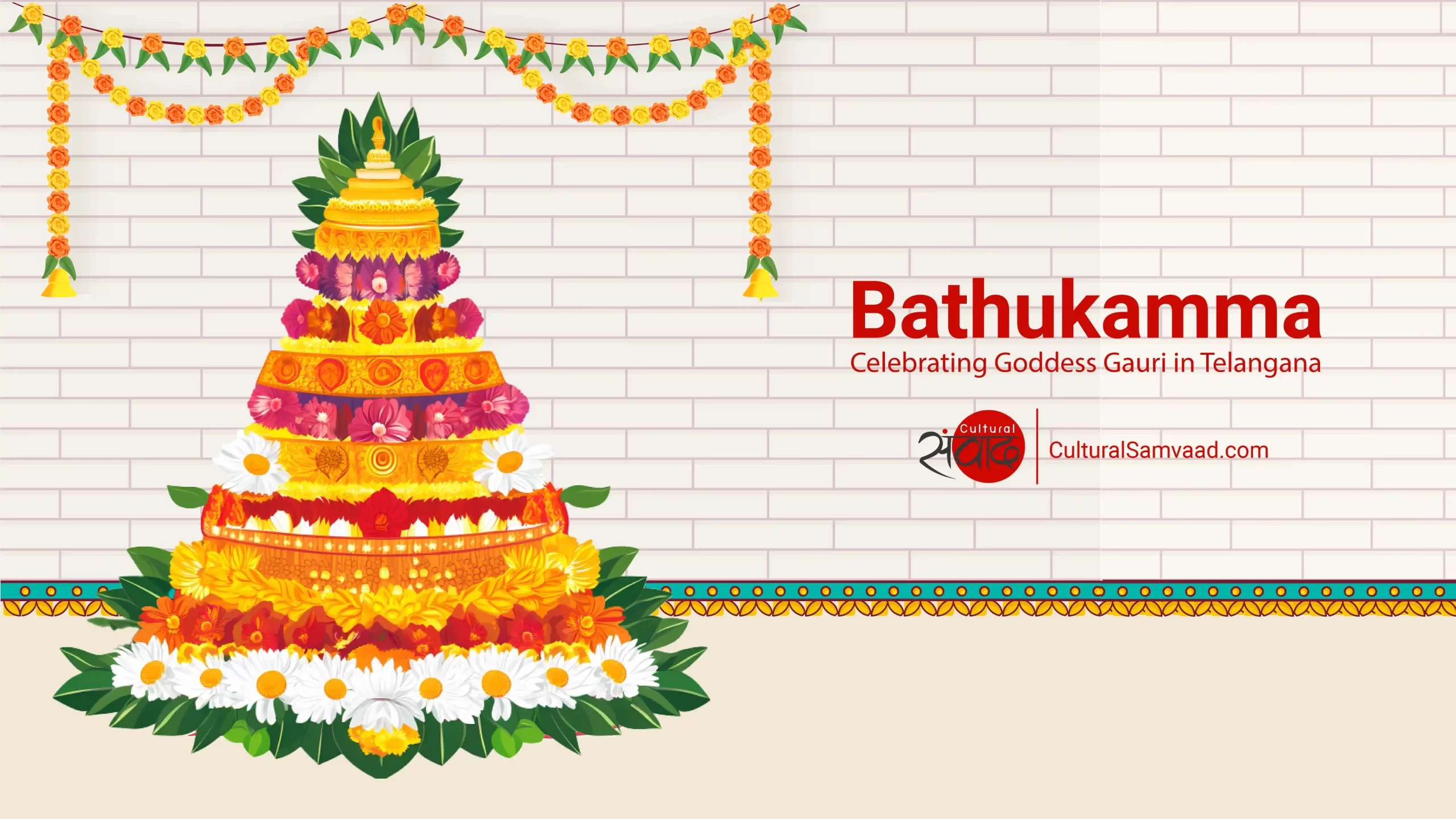Join Cultural Samvaad’s WhatsApp Community
India, that is Bharat, boasts of unfathomable tangible and intangible cultural heritage and natural heritage. Her stunning landscapes, infinite biodiversity and unending coastlines have nurtured the oldest continuous civilisation on earth. The kaleidoscope of monuments, sculptures and paintings that dot her land stand as testimony to the grand vision and unrelenting enterprise of her sons and daughters for millennia. Till date, 43 of India’s cultural, natural and mixed sites have been inscribed in the UNESCO World Heritage Sites List. Of these 43 sites, 35 are cultural sites, 7 are natural sites and 1 is a mixed site.
This is Cultural Samvaad’s attempt at presenting a bird’s eye view of the 43 UNESCO World Heritage Sites in India. We hope that both students and lay people find it useful.
Ajanta Caves
30+ Buddhist chaityas and viharas excavated between the 2nd century BCE and 6th century CE, these masterpieces of rock-cut architecture house unparalleled, breath-taking paintings and sculptures.
Ajanta Caves were inscribed in the UNESCO World Heritage List in 1983 and are situated in the Chhatrapati Sambhaji Nagar (earlier Aurangabad) district of Maharashtra.
Ellora Caves
A unique ensemble of 34 rock-cut caves extending over 2 kms and excavated between the 5th and 12th centuries CE, the Ellora sanctuary houses exquisite temples and monasteries dedicated to the three ancient Indic faiths – Hinduism, Buddhism and Jainism. The structures at the site include the breath-taking, monolithic Kailasanatha Temple.
Ellora Caves were inscribed in the UNESCO World Heritage List in 1983 and like the Ajanta Caves are situated in the Chhatrapati Sambhaji Nagar (earlier Aurangabad) district of Maharashtra.
Learn about the Temples of India that are part of the UNESCO World Heritage List
Agra Fort
Renovated by the Mughal emperor Akbar between 1565 and 1573 CE and modified subsequently by both Jahangir and Shah Jahan; the 94-acre vast, grand complex of Agra Fort was once the imperial seat of the Mughals.
Agra Fort was inscribed in the UNESCO World Heritage List in 1983. It is situated in Uttar Pradesh and is easily accessible from India’s capital – New Delhi.
Taj Mahal
A magnificent and moving ode in white marble, this mausoleum was constructed between 1631 and 1648 CE by the Mughal Emperor Shah Jahan in memory of his favourite wife, Mumtaz Mahal.
A photographer’s delight and a favourite spot of those in love, the Taj Mahal was inscribed in the UNESCO World Heritage List in 1983. It is situated in Uttar Pradesh, not too far from the Agra Fort.
Sun Temple, Konarak
Depicting the chariot of Surya Deva or Sun God with 24 giant wheels and led by 7 horses, this monumental and highly stylised work of art in stone in the Kalinga style dates back to the 13th century CE.
The Sun Temple located in Odisha was inscribed in the UNESCO World Heritage List in 1984.
Group of Monuments at Mahabalipuram or Mamallapuram
A veritable open-air museum of rock art, this group of sanctuaries were commissioned by the Pallava kings between the 7th and 8th centuries CE. This heritage site is renowned for its rathas (chariot-shaped temples), mandapas and magnificent open-air reliefs including the ‘Descent of the Ganga’.
The Group of Monuments at Mahabalipuram or Mamallapuram in Tamil Nadu was inscribed in the UNESCO World Heritage List in 1984.
Decipher the Great Bas Relief at Mammallapuram

Kaziranga National Park
The single largest undisturbed and representative area in the Brahmaputra Valley floodplain, the sanctuary at Kaziranga National Park in Assam houses the world’s largest population of one-horned Indian rhinoceroses; many mammals, including tigers, elephants, panthers and bears; thousands of birds and the Ganga River dolphin.
The Kaziranga National Park was inscribed in the UNESCO World Heritage List in 1985.
Keoladeo National Park
Man-made and man-maintained, this mosaic of grasslands, woodlands, woodland swamps and wetlands also known as Bharatpur Bird Sanctuary is a ‘Bird Paradise’. It is renowned not only for a large congregation of non-migratory resident breeding birds but also for resident birds, especially waterbirds.
The Keoladeo National Park located in Rajasthan was inscribed in the UNESCO World Heritage List in 1985.
Manas Wildlife Sanctuary
A biodiversity hotspot, the mesmerising Manas Wildlife Sanctuary located along the shifting river channels of the Manas River is home to a great variety of wildlife, including many endangered species, such as the tiger, greater one-horned rhino, swamp deer, pygmy hog, Indian elephant and Bengal florican.
The Manas Wildlife Sanctuary in Assam was inscribed in the UNESCO World Heritage List in 1985.
Churches and Convents of Goa
The seven churches and convents including the iconic Church of Bom Jesus were constructed between the 16th and 17th centuries CE in a unique Indo-Portuguese style when Old Goa was the capital of Portuguese Indies. They played an influential role in spreading Manueline, Mannerist and Baroque art and architectural influences (adapted to suit local resources and techniques) to Asian countries where Catholic missions were being established.
The Churches and Convents of Goa were inscribed in the UNESCO World Heritage List in 1986.
Discover the Churches and Convents of Goa
Khajuraho Group of Monuments
An ensemble of 23 Hindu and Jain temples including the breathtaking Kandariya Mahadeva Temple, the Lakshmana Temple and the Parshavanatha Temple; the Khajuraho Group of Monuments were built in the 10th and 11th centuries during the Chandella dynasty. The monuments are renowned for the harmonious integration of a multitude of sculptures with ornate architecture making them an aesthetic and spiritual delight.
Located in Madhya Pradesh, the site was inscribed in the UNESCO World Heritage List in 1986.
Group of Monuments at Hampi
The last capital of the Vijayanagara empire, this ancient site, which was pillaged and abandoned in 1565 CE, is home to over 1600 stunning architectural remains including the Vitthala temple complex, the Virupaksha temple, the Hazara Rama temple, the Queen’s Bath and the Elephant Stables.
The Group of Monuments at Hampi is located in Karnataka and was inscribed in the UNESCO World Heritage List in 1986.
Fatehpur Sikri
The ‘City of Victory’ – Fatehpur Sikri was the first planned city of the Mughals and their capital for about 10 years. It was constructed by Emperor Akbar between 1571 and 1573 CE and is home to imposing monuments and temples which include the Jama Masjid with the famous Buland Darwaza as its main entrance, the Panch Mahal palace and the Tomb of Salim Chishti.
Fatehpur Sikri is located in Uttar Pradesh and was inscribed in the UNESCO World Heritage List in 1986.
Group of Monuments at Pattadakal
Nine Hindu temples including the large and sophisticated Virupaksha Temple (not to be confused with the Virupaksha Temple at Hampi) and a Jain sanctuary constructed by the Chalukyas constitute the Group of Monuments at Pattadakal. They were constructed between the 7th and 8th centuries CE in a striking art form that blends the northern and southern styles.
The Group of Monuments at Pattadakal in Karnataka was inscribed in the UNESCO World Heritage List in 1987.
Elephanta Caves
Imposing rock-cut caves dating back to the 5th to 6th centuries CE, the Elephanta Caves house sculptural masterpieces devoted primarily to Shiva including the iconic 7-m-high Sadashiva (commonly but erroneously referred to as Trimurti).
The Elephanta Caves inscribed in the UNESCO World Heritage List in 1987 are located in Maharashtra, just off the coast of Mumbai.
Great Living Chola Temples
Built by kings of the Chola Empire during the 11th and 12th century, the group of three Hindu living temples – the Brihadisvara Temple at Thanjavur (known as Dakshina Meru in inscriptions), the Brihadisvara Temple at Gangaikondacholisvaram and the Airavatesvara Temple at Darasuram are examples of the brilliance of Chola architecture and art at its best.
The Great Chola Living Temples are located in Tamil Nadu. While the Brihadisvara Temple at Thanjavur was inscribed in the UNESCO World Heritage List in 1987, the other two temples were inscribed in 2004.
Sundarbans National Park
Located at the mouth of the Ganga and Brahmaputra rivers in West Bengal and home to the world’s largest mangrove forests, this picturesque and most biologically productive natural ecosystem boasts of a number of rare and endangered species including tigers, aquatic mammals, birds and reptiles as its inhabitants.
The Sundarbans National Park was inscribed in the UNESCO World Heritage List in 1987.
Nanda Devi and Valley of Flowers National Parks
Located in the exceptionally beautiful high-altitude West Himalayan landscapes, the Nanda Devi and Valley of Flowers National Parks in Uttarakhand encompass a unique transition zone between the mountain ranges of the Zanskar and Great Himalayas. They are home to high diversity and density of flora and fauna including rare and endangered species.
While the Nanda Devi National Park was inscribed in the UNESCO World Heritage List in 1988, the Valley of Flowers National Park was inscribed in 2005.
Buddhist Monuments at Sanchi
Home to the famous Sanchi Stupa with four intricately carved toranas, this stone sanctuary located on a hill was a critical centre of Buddhism from the 3rd century BCE to the 12th century CE. The site houses several free-standing pillars, stupas, temples and monasteries.
The Buddhist Monuments at Sanchi are located in Madhya Pradesh and were inscribed in the UNESCO World Heritage List in 1989.
Humayun’s Tomb, Delhi
Built in the 1560s, the monumental double-domed Mughal mausoleum. the Humayun’s Tomb is the first garden tomb on the Indian subcontinent. It stands on a high, wide-terraced platform and is an exquisite example of the Charbagh (four quadrant garden with representations of the four rivers of jannat or the Quranic paradise).
Humayun’s Tomb is located in India’s capital – New Delhi and was inscribed in the UNESCO World Heritage List in 1993.
Qutb Minar and its Monuments, Delhi
This rich archaeological area is home to the 72.5m high, red sandstone tower of Qutb Minar, funerary buildings including the magnificent Alai-Darwaza Gate, two mosques including the Quwwatu’l-Islam, the Alai Minar and other structures built in the 13th and 14th centuries during the Delhi Sultanate period. Remains of earlier Hindu and Jain temples were repurposed during construction of some of the monuments.
Qutb Minar and its Monuments are located in India’s capital – New Delhi and were inscribed in the UNESCO World Heritage List in 1993.
Mountain Railways of India
Three outstanding hill railways of India that were opened between 1881 and 1908 and are still fully functional and operational are inscribed in the UNESCO World Heritage List.
The Darjeeling Himalayan Railway located in the foothills of the Himalayas in West Bengal was inscribed in 1999, the Nilgiri Mountain Railway located in the Nilgiri Hills of Tamil Nadu was inscribed in 2005 and the Kalka-Shimla Railway located in the Himalayan foothills of Himachal Pradesh was inscribed in 2008.
Mahabodhi Temple Complex at Bodh Gaya
The imposing brick temple at the site referred to as the Mahabodhi Temple is generally dated between the 5th and 6th centuries CE. The earliest temple at Bodh Gaya is popularly attributed to the Mauryan Emperor Ashoka who is supposed to have constructed it in the 3rd century BCE at the holy site where Gautama Buddha attained enlightenment under the Bodhi Tree. The temple was restored and renovated a number of times including in the Pala period and in the late 19th century.
Located in Bihar, the Mahabodhi Temple Complex at Bodh Gaya was inscribed in the UNESCO World Heritage List in 2002.
Rock Shelters of Bhimbetka
The five clusters of Bhimbetka rock shelters situated in the foothills of the Vindhyan Mountains are replete with paintings from the Mesolithic Period to the Historical Period. Some cultural practices in villages adjacent to the site still resonate with the vivid depictions of the rock paintings establishing an unbroken link to the past.
The Rock Shelters of Bhimbetka in Madhya Pradesh were inscribed in the UNESCO World Heritage List in 2003.
Champaner-Pavagadh Archaeological Park
Pavagadh hill and its precincts are home to multiple archaeological, historic and living cultural heritage properties dated from the prehistoric period to the 16th century CE. The include the famous Kalikamata Temple, the Jama Mosque, Jain temples, water-management systems, fortifications, palaces and residential and agricultural structures. Large parts of the site are still unexcavated.
The Champaner-Pavagadh Archaeological Park is located in Gujarat and was inscribed in the UNESCO World Heritage List in 2004.
Chhatrapati Shivaji Terminus (formerly Victoria Terminus)
A living ode to the spirit of Mumbai, her commercial prowess, her people and her importance as a port city, the construction of this imposing terminal commenced in 1878. Built over 10 years, it is one of the finest examples of the confluence of Victorian Gothic Architecture, influences from Italian Gothic Architecture and themes from traditional Indian Architecture.
Chhatrapati Shivaji Terminus (formerly Victoria Terminus) in Mumbai in Maharashtra was inscribed in the UNESCO World Heritage List in 2004.
Red Fort Complex
Constructed in the 17th century CE as the palace fort of Mughal emperor Shah Jahan’s new capital city – Shahjahanabad, the grand Qila referred to as the Red Fort is enclosed by massive walls of red sandstone. It took 9 years to complete and is situated in the heart of India’s capital – New Delhi.
The Red Fort Complex continues to be an important landmark in independent India and was inscribed in the UNESCO World Heritage List in 2007.
The Jantar Mantar, Jaipur
Built in the early 18th century CE, this well-preserved, monumental astronomical observation site commissioned by the Kachwaha Rajput ruler – Jai Singh II was a meeting point for different scientific cultures. It includes a set of some 20 main fixed instruments which embody several architectural and instrumental innovations.
The Jantar Mantar, Jaipur in Rajasthan was inscribed in the UNESCO World Heritage List in 2010.
Western Ghats
An ancient chain of mountains running parallel to India’s western coast and traversing the states of Kerala, Tamil Nadu, Karnataka, Goa, Maharashtra and Gujarat, the mesmerising Ghats are one of the world’s eight ‘hottest hotspots’ of biological diversity besides containing areas of high geological, cultural and aesthetic values.
The Western Ghats were inscribed in the UNESCO World Heritage List in 2012.
Hill Forts of Rajasthan
The inscribed site constitutes of six extensive and majestic forts in Chittorgarh, Kumbhalgarh, Sawai Madhopur, Jhalawar, Jaipur and Jaisalmer. They boast of eclectic architecture including extensive water harvesting structures and together reflect the elaborate, fortified seats of power of the relatively politically independent Rajput princely states that flourished between the 8th and 18th centuries CE.
The Hill Forts of Rajasthan were inscribed in the UNESCO World Heritage List in 2013.
Rani-ki-Vav (the Queen’s Stepwell) at Patan, Gujarat
Initially a memorial built on the banks of the Saraswati River in the 11th century CE, this magnificent monument was a religious and functional structure. It is divided into seven levels of stairs with sculptural panels of high artistic quality and is designed both as an inverted temple highlighting the sanctity of water and as a single-component, water management system with all the features of a stepwell.
Rani-ki-Vav which is located in Gujarat was inscribed in the UNESCO World Heritage List in 2014.
Great Himalayan National Park Conservation Area, Himachal Pradesh
Located in the western part of the Himalayan Mountains; this compact, natural and biodiverse protected area system not only includes 25 types of forests and an associated rich assemblage of flora and fauna species (including several threatened species) but also encompasses the upper mountain glacial and snowmelt water sources of several rivers, and the catchments of water supplies that are vital to millions of downstream users.
The Great Himalayan National Park Conservation Area, Himachal Pradesh was inscribed in the UNESCO World Heritage List in 2014.
Archaeological Site of Nalanda Mahavihara
Home to one of ancient India’s most famous universities which was a global centre of learning for over 800 years before its unfortunate destruction, the site is studded with Buddhist monuments including stupas, shrines, viharas and works of art dated between the 3rd century BCE and 13th century CE.
The Archaeological Site of Nalanda Mahavihara in Bihar was inscribed in the UNESCO World Heritage List in 2016.
Khangchendzonga National Park, Sikkim
Located at the heart of the Himalayas, the site is home to the world’s third highest peak, Mount Khangchendzonga. The National Park boasts of a unique diversity of plains, valleys, lakes, glaciers and snow-capped mountains covered with ancient forests and unimaginable biodiversity in addition to being revered as Mayel Lyang by the indigenous people and as a beyul (sacred hidden land) in Tibetan Buddhism.
The Khangchendzonga National Park in Sikkim was inscribed in the UNESCO World Heritage List in 2016.
Complexe du Capitole in Chandigarh
Designed by Le Corbusier as the focal point of the plan for the city of Chandigarh, the Capital Complex is seen as the most complete contribution to the principles of the Athens Charter as revised by him. It promotes the concept of balance between the collective and the individual and to the idea of the Radiant City.
The Complexe du Capitole in Chandigarh is part of the transnational serial property spread across seven countries on three continents –The Architectural Work of Le Corbusier, an Outstanding Contribution to the Modern Movement and was inscribed in the UNESCO World Heritage List in 2016.
Historic City of Ahmadabad
Founded by Sultan Ahmad Shah in 1411 CE on the eastern bank of the Sabarmati River, the walled city with a rich, multicultural fabric has flourished as the capital of Gujarat for over six centuries. It is dotted with numerous mosques, tombs and Hindu and Jain temples among other significant monuments and boasts of unique timber-based architecture and densely packed traditional houses with gated streets in typical neighbourhoods that are called pols.
Ahmadabad was inscribed in the UNESCO World Heritage List in 2016.
Victorian Gothic and Art Deco Ensembles of Mumbai
A testimony to the phases of modernisation of Mumbai in the 19th and 20th centuries CE, the site boasts of a spectacular ensemble of Victorian Gothic buildings with Indian elements suited to the climate on the eastern side of Oval Maidan, and another impressive ensemble of unique Art Deco residential, commercial and entertainment edifices, that blend Indian design with Art Deco imagery on its western side.
The Victorian Gothic and Art Deco Ensembles of Mumbai were inscribed in the UNESCO World Heritage List in 2018.
Jaipur City, Rajasthan
A unique walled city built according to a grid plan in the 18th century CE under the patronage of Sawai Raja Jai Singh II, it was deliberately located on the plains to catalyse trade and commerce. Jaipur is today the capital of Rajasthan and is a living expression of the astronomical skills, living traditions, unique urban form and exemplary innovative city planning of its time.
The picturesque ‘Pink City’ was inscribed in the UNESCO World Heritage List in 2019.
Dholavira: A Harappan City
A walled ancient city, this well-preserved Harappan site was occupied for almost 1500 years from 3000 BCE to 1500 BCE and boasts of a sophisticated water management system, bead processing workshops and a large cemetery with six types of cenotaphs in addition to other characteristic urban features of the Sindhu-Saraswati or Indus Valley Civilisation.
Dholavira is situated in Gujarat was inscribed in the UNESCO World Heritage List in 2021.
Learn about the Important Cities of the Harappan Civilisation
Kakatiya Rudreshwara (Ramappa) Temple, Telangana
A stunning Shiva temple constructed by the Kakatiya rulers in the early part of the 13th century CE, the building is not only richly decorated with exquisite sculptures that bring to life regional dance customs and culture but also harmoniously blends with its natural setting and surroundings in line with dharmic texts. It is referred to as Ramappa temple in honour of its designer and chief architect – Ramappa.
Kakatiya Rudreshwara (Ramappa) Temple is situated in Telangana and was inscribed in the UNESCO World Heritage List in 2021.
Sacred Ensembles of the Hoysalas
Built during the Hoysala era during the 12th and 13th centuries, the Channakeshava Temple at Belur , the Hoysalesvara Temple at Halebidu and the Keshava Temple at Somanathapura are richly experiential and ornamented. Their visually astounding, intricate sculpture brings alive religious narratives and beliefs in stone.
The Sacred Ensembles of Hoysala are located in Karnataka and were inscribed in the UNESCO World Heritage List in 2023.
Santiniketan
Established in 1901 by Rabindranath Tagore, Santiniketan is a living institution that fuses ancient Indian ideas and aesthetics with internationalism and modernism. This confluence is embodied in its buildings, landscape, artworks and continuing festivals and traditions.
Santiniketan is situated in West Bengal and was inscribed in the UNESCO World Heritage List in 2023.
Moidams – the Mound-Burial System of the Ahom Dynasty
Moidams are an integral part of the landscape of Assam and were inscribed in the UNESCO World Heritage List in 2024.
Closing Remarks
The cultural and natural sites designated by UNESCO as World Heritage sites represent a tiny fraction of living examples of India’s rich and plural past and the infinite bounty that nature has bestowed on her. It is not only our duty as a people to preserve and conserve but also to build and augment so that the onward march of India that is Bharat continues unabated into eternity.
For more information, please visit: https://whc.unesco.org/en/statesparties/in






A few were already in bucket list which further got improvised with further addition. Wonderful article.